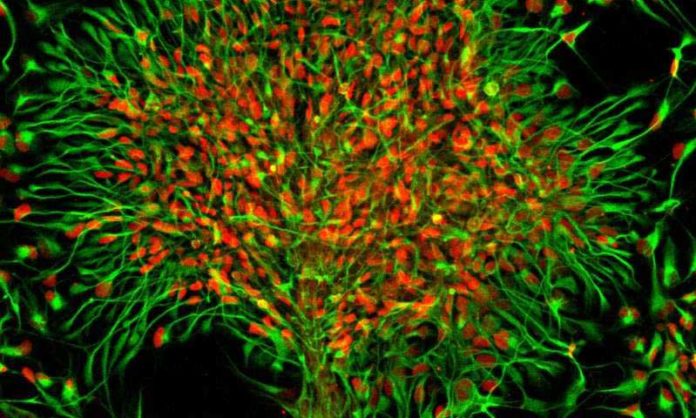Since the split from the last common ancestor of hominins (Homo) and African apes, human brain evolution has been characterized by several waves of increases in cranial capacity and selective expansion of regions implicated in complex cognition.
The increase in the cranial capacity in fossil hominins has been tied to behavioral changes, including the appearance of the first stone tools and their subsequent elaboration, increases in population size. While these changes cannot be inferred directly from the fossil specimens, comparative analyses of cortical organization between extant primate species suggest that the human brain indeed differs from the brain of other hominid species in several important microstructural aspects.
Now, a new study by the Salk Institute, in collaboration with researchers from the anthropology department at UC San Diego, have developed a method to more easily study the early development of human neurons compared with the neurons of nonhuman primates. The study offers key insights into the developmental organization of the brain and lays the groundwork for further comparative analyses between humans and nonhuman primates.
Two vital procedures in brain development incorporate neuron maturation and migration. Maturation includes neuron growth as the neurons increase their associations between one another for better communication. Migration is the physical movement of neurons into various parts of the developing brain.
During the study, scientists looked to analyze neuron maturation and migration among people and nonhuman primates. To do so, the scientists devised a method using stem cell technology to take skin cells from primates and coax them, via a virus and chemical cocktails, to develop into neural progenitor cells, a cell type that has the ability to become multiple types of cells in the brain, including neurons.
These new primate cell lines would then be able to be never-ending proliferated, permitting analysts new roads to examine parts of neuronal advancement of live neurons without tissue samples from endangered primates, for example, chimpanzees and bonobos.
Scientists primarily explored the variations in the in gene expression related to neuronal movement. They also investigated the migration properties of the neurons inherent to each species.
They found almost 52 genes related to migration, and, interestingly, chimpanzee and bonobo neurons had periods of rapid migration, while human neurons were slow to move.
While comparing neuron movement and maturation, scientists transplanted the neural progenitor cells from both humans and chimpanzees into the brains of rodents. Doing so enabled the neurons to thrive and providing additional developmental cues for the neurons to develop.
Scientists then observed the variations in migration distance, shape and size of the neurons for up to 19 weeks after transplantation. They observed the length, density, and quantity of extensions of the neurons called dendrites, as well as the size of the cell bodies, which house the nucleus and DNA.
The chimpanzee neurons migrated a greater distance and covered a 76 percent greater area than the human neurons after two weeks. Human neurons were slower to develop but reached longer lengths than the chimpanzee neurons. This slower growth pattern may allow humans to reach more developmental milestones than nonhuman primates, which could account for differences in behavior and cognitive abilities.
Carol Marchetto, a Salk senior staff scientist in the Laboratory of Genetics, co-first author and one of the study’s senior authors said, “This is a novel strategy to study human evolution. We are happy to share these primate cell lines with the scientific community so that researchers from around the world can examine primate brain development without the use of tissue samples. We anticipate this will lead to numerous new findings over the next few years about the brain’s evolution.”
Scientists are further expecting to construct an evolutionary tree of multiple primate species using induced pluripotent stem cell lines. This will help them better understand the evolution of the human brain. Moreover, scientists have planned to use this platform to study gene regulation differences between primate species that underlie the differences in neuronal maturation and can potentially impact brain organization in humans.
Marchetto said, “We have limited knowledge about the evolution of the brain, especially when it comes to differences in cellular development between species. We’re excited about the tremendous possibilities this work opens up for the field of neuroscience and brain evolution.”
The study is published in the journal eLife.
